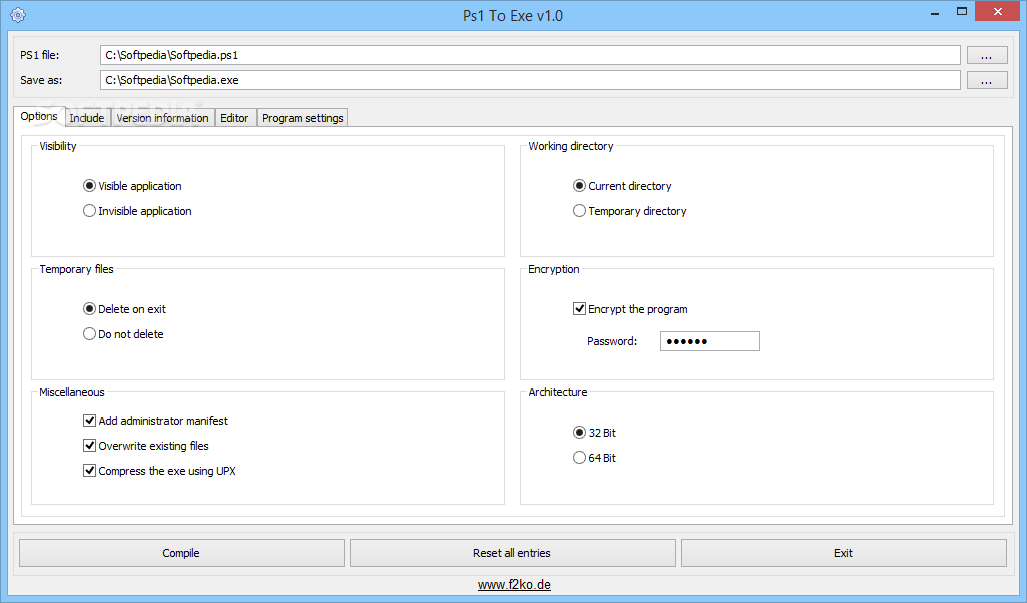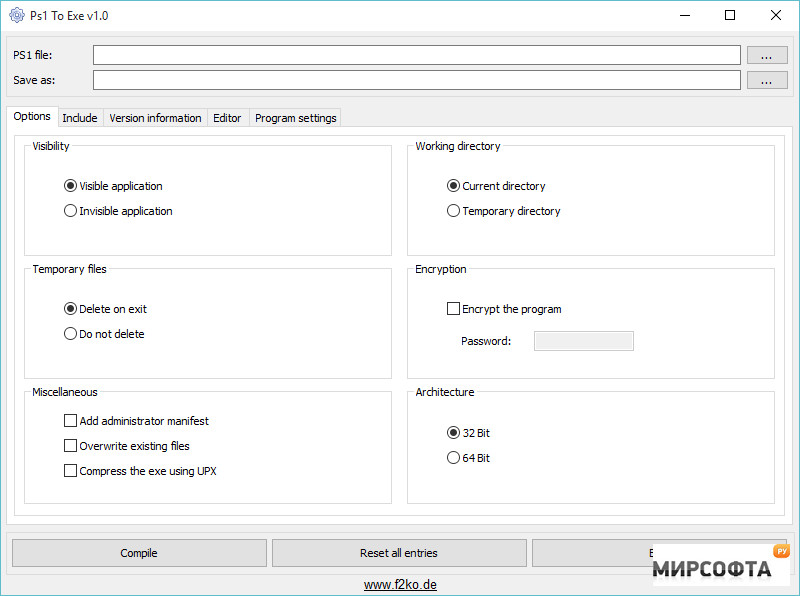Compile Ps1 To Exe Android App For Blackberry Free Download Adb Driver Network Driver For Samsung Laptop Sonic Exe 3 Manycam 3.1 Download Stop Motion Pro App Microsoft Vista Upgrade To Windows 7 Free Free Css Templates Org Original Starcraft Free Download Ncs Expert Inpa Ediabas Download Alif Laila Episode. Actually what I do to 'convert' a ps1 file to exe is: I run iexpress.exe to create a self-extracting archive and accept all default settings. I put the launcher.vbs script and my ps1 script into that archive when I am asked to add files. I put this into 'Install Command': wscript.exe launcher.vbs. Then I accept again all default settings.
Hello everybody, new place new posts…
Sometimes I need to convert my PowerShell scripts (.ps1) into Executable files (.exe) for many different reasons. I’m sure you’ll face or you’ve already faced one similar situation too .
Once a client’s 4th line team has been asked by MS support to collect different logs from 6K+ workstations and send it back to them. The tricky part was the log collection should be started at the time of having the issue. Ok for 1 to 5 workstations you can ask your service desk personnel to get contact, explain the end-user that they’ve to contact service desk when they’ve the issue and at that time service desk personnel should launch that and that scripts in that special order. Finally when it finishes collect the different logs from different paths and zip them and then send it back to 4th line for sending back it to MS. But what if Service desk guy forgets to run the scripts in order ?? what if the end-user can’t contact the service desk guy at the time of issue because suddenly his skype or his workstation doesn’t respond ??
Convert PowerShell scripts into Windows executables. Version 1.1.0.3 (9.July.2019) PowerShell Code. From the developer: Ps1 To Exe can convert Windows PowerShell (PS1) code into executable programs (EXE). It has the ability to create both 32- and 64-bit applications. Created EXE can have an interface or be invisible. Inclusion of additional supporting files, folders, icon, and version information is possible. I want to know if anyone knows some good softwares that compile.ps1 file into.exe files to make them executable. I know that it’s possible and I’ve tried PS2EXE but it didn’t work on my version of windows for some reason. If anyone know any other ways or any other softwares that work with windows ten it would be very helpful.
Wow wow woow.. what a long story … lots of things should be done in order.. but hey wait what if we write a PowerShell script which runs all required commands in order, collects the logs somewhere on the workstation and zips the logs , then send logs to a central share somewhere on the network ??? that would be cool isn’t it ?? you’d just check that central share sometimes and send the collected zipped log files to MS . You eliminate lots of human errors.. That would be even better if you could deploy your PowerShell script on end-user’ desktops for example and ask them to click on it once when they have the issue.. but in Enterprise environments a standard user would probably have some issues when launching a PowerShell script and also it would be difficult to explain how to launch a PowerShell script. Some of them may even try to modify your script. The best solution can be just to convert your PowerShell script into an executable (.exe) file , deploy it on end-users’ desktops by using GPP or ConfigMgr for example and ask the user to click on this exe when the issue happens. Easy solution just needs end-user’s simple click then everything is done automatically 🙂

I know I know .. now there are lots of alternatives, but what I use since a long time is PS2EXE which can be found here (author is Ingo Karstein ): https://gallery.technet.microsoft.com/scriptcenter/PS2EXE-Convert-PowerShell-9e4e07f1
I’ve also seen the following versions (but never tried, you can try them at your own risk) :
– Azure version: https://ps2exe.azurewebsites.net/
– GUI version: https://gallery.technet.microsoft.com/scriptcenter/PS2EXE-GUI-Convert-e7cb69d5
Before to start to explain PS2EXE you should know that PS2EXE itself is a PowerShell script that converts your PowerShell script to Executable. In fact your the tool encapsulates your PowerShell script to an executable file.
More description about it can be found in the related PS2EXE TechNet link : “It does not convert the PowerShell script to an other language! It encapsulates the script with a lightweight PowerShell host written in C# and compiles the dynamically generated C# source code in memory to an EXE file. The resulting EXE is an .NET assembly that contains the source script encoded in Base64. The EXE includes all stuff that is needed to execute an PowerShell through the .NET object model. It is based on classes in the namespace System.Management.Automation that reperents the PowerShell engine. – Therefore the EXE file is not a real “standalone” EXE file. It needs PowerShell to be installed!!! And – of course – it needs .NET Framework v2.0. Furthermore “script execution” have to be allowed (see cmdlet: set-execultionpolicy). – The resulting EXE is “MSIL” and is able to execute as x64 or x86.”
Ok but how it works ??
Me, I’ve a folder on my PC with PS2EXE in it:
When I need to convert a PowerShell script to Executable I just move the .ps1 file here :
Then I launch my PowerShell and cd to this directory :
Usage is fairly easy: ./PS2EXE.ps1 –InputFile “PATHName_of_script_to_be_ converted.ps1” –OutputFile “PATHName_of_excutable_file.exe”
But before to run it check your execution policy:

You can find detailed explanation about Execution Policies here.
If it’s Restricted then you can to use the following line to bypass execution policy during your script execution: powershell –ExecutionPolicy Bypass
Powershell Script To Exe
That will start a PowerShell session that allows for running scripts and keeps the lowered permissions isolated to just the current running process.
Now just run the PS2EXE :
And your .exe file is ready to use !!

Compile Ps1 To Exe Emulator
Easy isn’t it ?? Hope that helps you one day !! what about the script ? I’ll post it next time 😉
/sencer/
( This information is provided “AS IS” with no warranties , use it at your own risk )
Hi all. As mentioned in another thread somewhere here, I’ve switched from Autoit to Powershell for pretty much all of my scripting. Anything truly automated I use PDQ Deploy for. We have a number of applications that we don’t necessarily deploy automatically, but are “as-required” and the users just launch the install from a shared folder. In the past the shared folder had a shortcut to the compiled Autoit script. Now we have a shortcut to a .cmd file that launched the powershell script like:
Powershell -file “servershareproductinstallscript.ps1”This works just fine, but seems a bit, well, sloppy. I could compile the Powershell like I did with Autoit. How does everyone else handle launching ps1 files?
Hi Steve, great question. I think a cmd file is pretty standard, but agree it isn’t the best presentation for an end user. This was actually the original problem I was trying to solve with the Script Packager feature of the Admin Script Editor. Some scripts need a command line interpreter, and other possible external dependancies which even make delivery even more of a challenge. PowerShell isn’t a language that can be “compiled” but it (and anything really) can be packaged. The result is essentially a self extracting executable that cleans itself up after running out of the %temp% folder. It doesn’t sound like your environment is locked down, but the feature also supports the setting of alternate credentials so that users that don’t have permission to install the software, could do so without prompting.
Or see the Script Packager closer in this video:
The way the ASE Script Packager handles arguments is that it exposes it as an environment variable you can parse in your script. The full command line is to be handled as a string by reading %ASEEXEARGS% where you can take actions based on what you find accordingly.
Having %temp% locked down is rather unusual, this is the default target for extraction and execution because most every user is able to write here– if you have designated another location for such it can be specified in the settings for the Script Packager.
